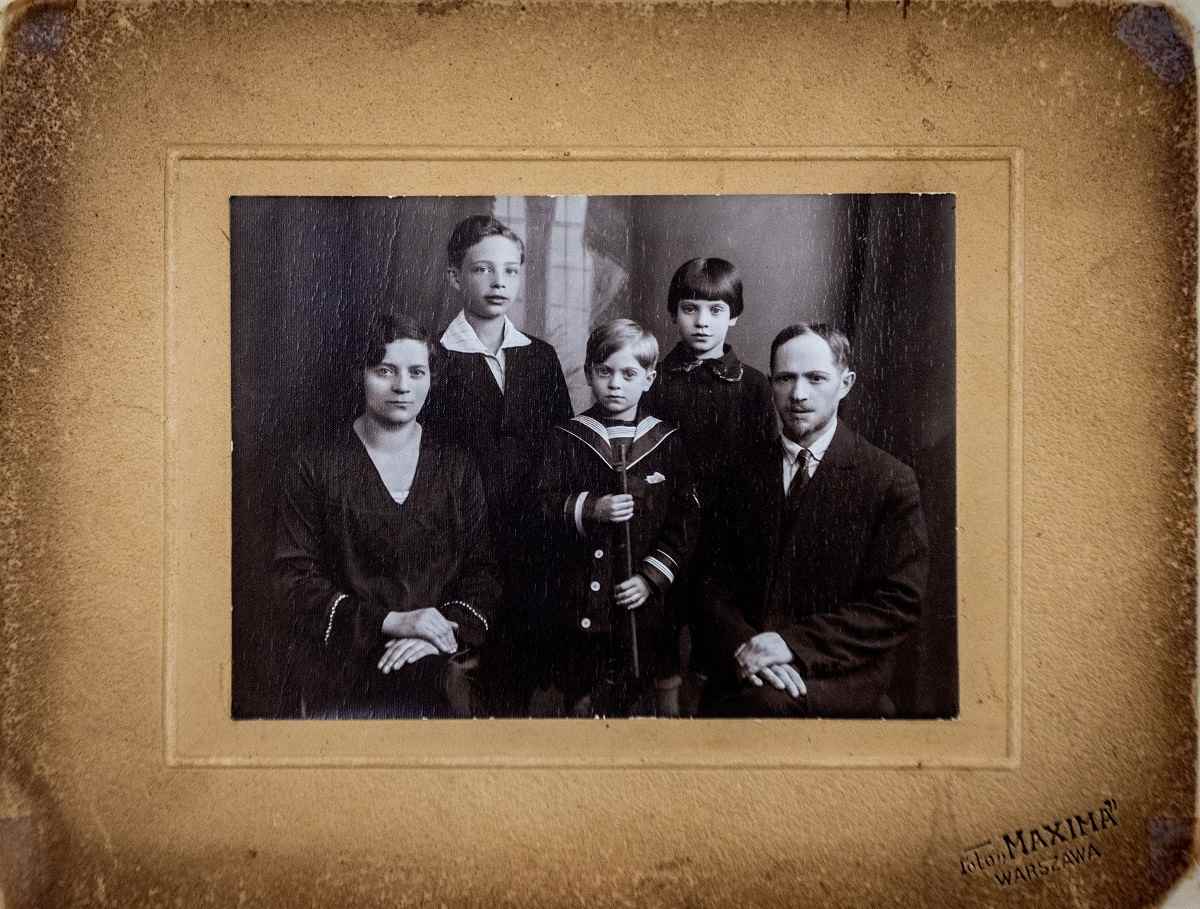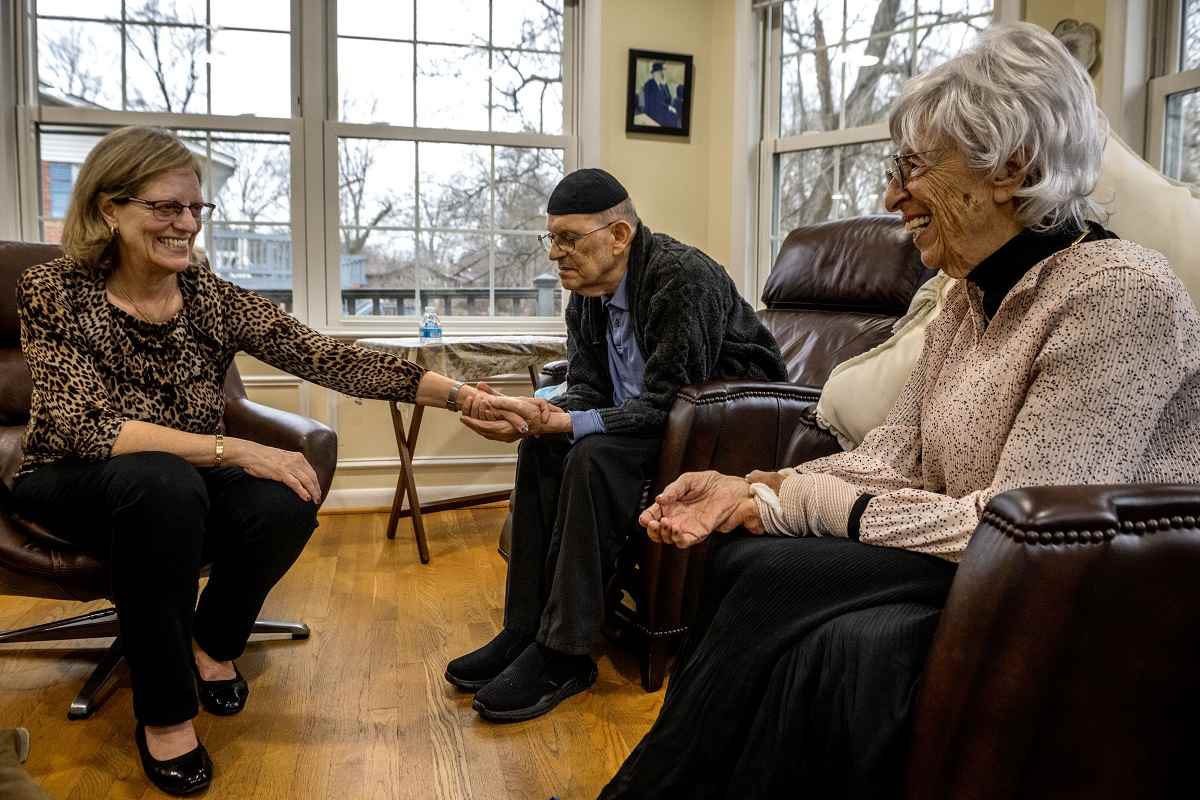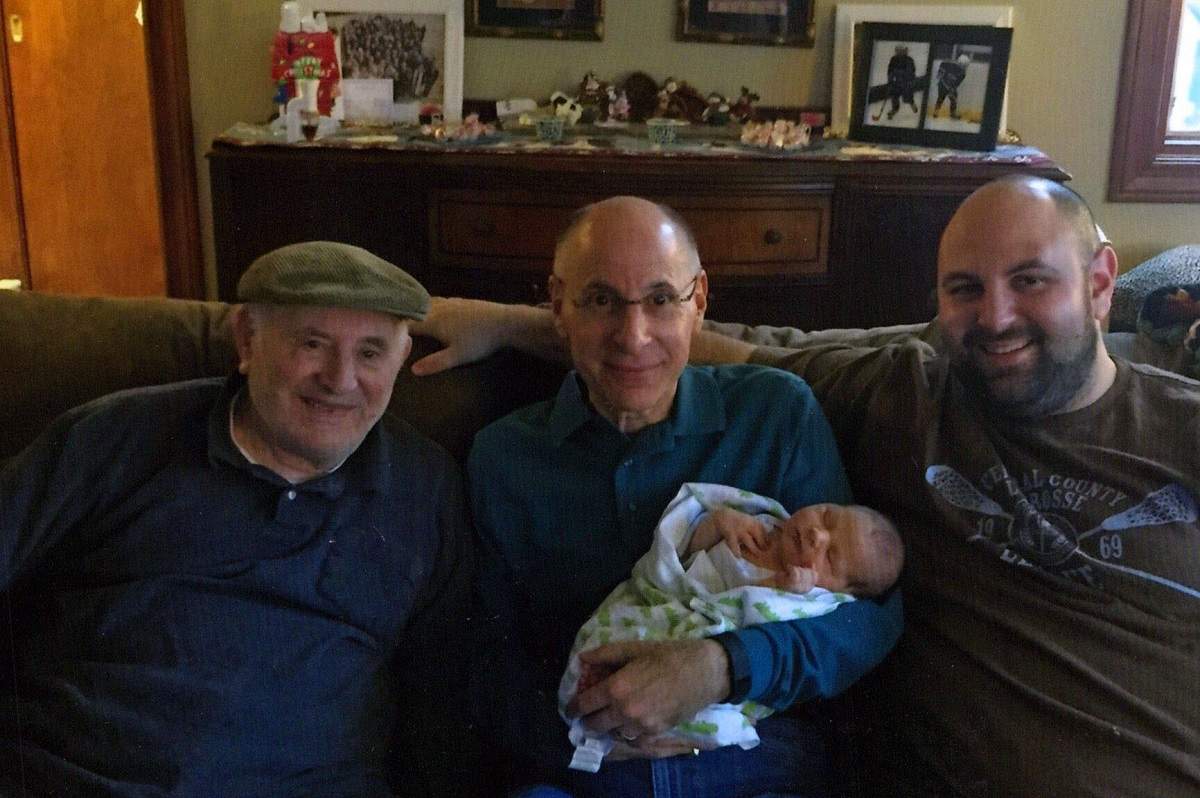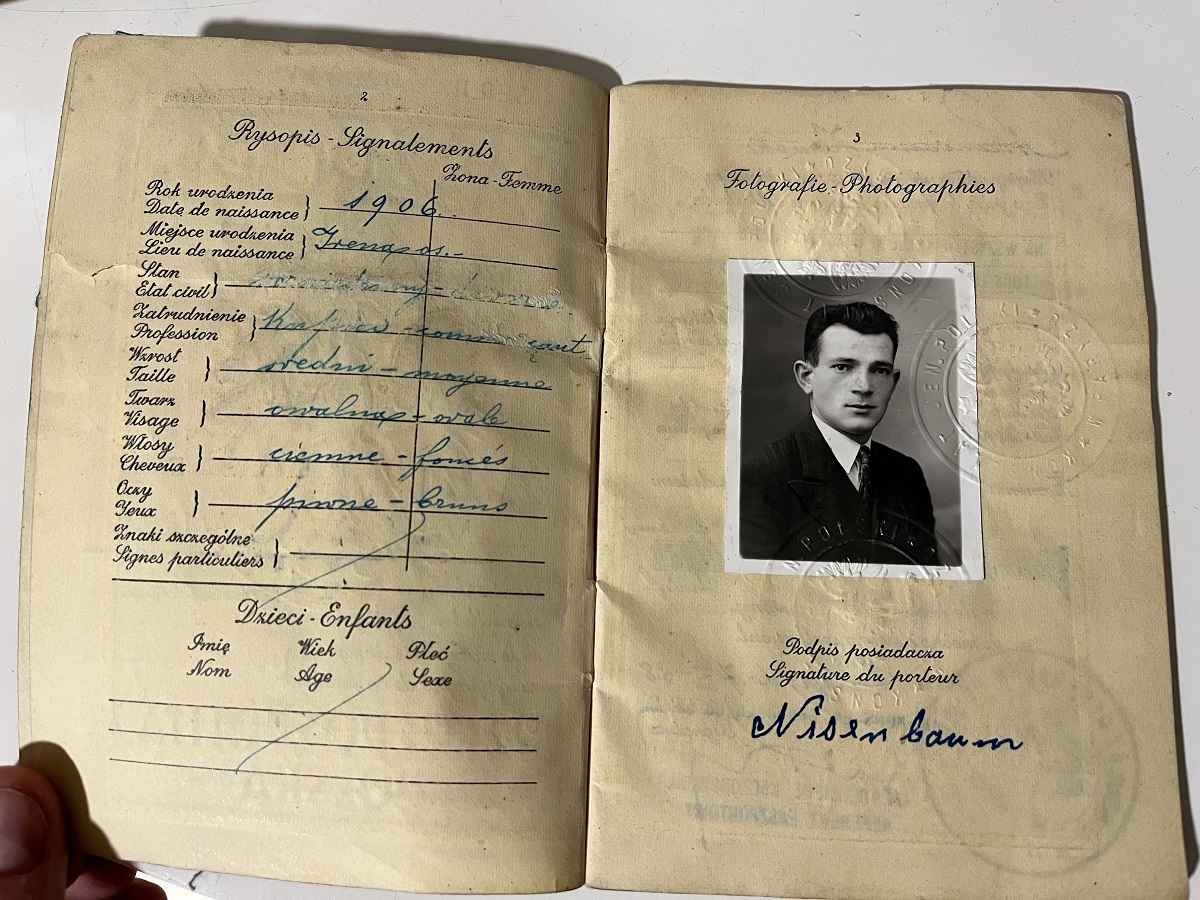
family photo from Holocaust survivor Michael Novice, center. After the war, he and his siblings searched in vain for their parents, brother and other relatives.
14:05 JST, December 14, 2023
Judi Roth grew up in Elmira, N.Y., never having known her father’s parents.
Her father, Michael Novice, a Polish Holocaust survivor, escaped the Warsaw ghetto at 13 and lived through three concentration camps. After the war, he and two siblings searched in vain for their parents, brother and cousins. Novice, a physicist, eventually moved to the United States, where he raised three children.
For years, Roth, his oldest child, searched for anyone on her father’s side who might have survived, finding a few distant relations scattered across South America and Europe. But she wondered whether there were more.
“Family was so important to him,” Roth, 67, said of her father, who is 96 and has dementia. “It still is.” The home he and his wife share in Potomac, Md., is lined with family photos from before the war, tantalizing glimpses of the relatives Roth never knew.
Then, scrolling on Facebook late last year, she learned of an initiative sponsored by the Center for Jewish History, one that was sending DNA test kits to Holocaust survivors and their children. The DNA Reunion Project’s goal was to see whether, somewhere in the world, they can find meaningful genetic matches and mend family trees that genocide had sundered.

Judi Roth, left, visits her parents, Ruth and Michael Novice, in January in Potomac, Md. “Family was so important to him,” Roth said of her father, a Holocaust survivor who has dementia.
It’s a mission the project’s founders say feels more pressing now than ever, in light of the Oct. 7 Hamas attacks in Israel, the largest slaughter of Jewish people since the Holocaust. It is also pressing because of the advanced age of remaining Holocaust survivors. In many cases, the genetic discoveries will most benefit descendants like Roth.
Since its launch a year ago, the reunion project has mailed more than 1,000 kits to 17 countries. The genealogy company Ancestry has donated 2,500 kits, and the project also encourages participants to upload samples to other commercial registries, in the hope that as the databases grow, matches will become more likely.
That was Roth’s hope, too. She contacted the project and sent in her father’s sample.
What she, like others involved in the project, would discover, was bittersweet.
***
The DNA Reunion Project launched as a six-month, $40,000 pilot, led by genealogists Jennifer Mendelsohn and Adina Newman, that has since expanded as funding has increased. Mendelsohn and Newman, who each have relatives who were killed in the Holocaust, specialize in Ashkenazi Jewish communities, and they had already been helping survivors’ families build out their ravaged family trees.
Often, they said, there is more to find than people expect. “There’s a huge and pernicious myth in the Jewish community that the Nazis destroyed all the Jewish records during World War II so that we can’t trace our families back,” Mendelsohn said. “That is absolutely, categorically not true.”
The misconception has discouraged many people from searching, said Newman, who lives in Boston and works remotely with Mendelsohn, who lives in Baltimore. “We want people to know, we want to shout it from the rooftops: ‘Please test. Please know that it’s not a lost cause,'” Newman said.
At first, the two genealogists had hoped that launching the project “would lead to some of those home-run incredible reunions,” Mendelsohn said. But a year into the project, they have learned, “we have to be patient.”
Time is also an enemy. Eight decades after the Holocaust, most who survived it have died. Others, like Novice, who helped design the camera used by the first men on the moon, now have diminished cognitive functioning. (The DNA Reunion Project mandates that anyone contributing samples must be able to consent; Roth said she was unaware of the rule.)
“I wish this could have been done decades ago, even a decade ago. But we didn’t have the level of participation and large enough databases to really make progress up to now,” said CeCe Moore, a genetic genealogist who founded the organization DNA Detectives.
When Roth received an email from Ancestry in the spring saying the results were ready to view, she and her mother sat together at her parents’ dining table, a few feet from where Novice rested in his easy chair, and opened the file.
“Dad, look. In the computer, we’ve got names of people who are cousins of yours,” Roth said, peering at the screen. “A lot of second and third cousins.” It showed 4,500 people related to him. She kept scrolling. Now there were 13,000 matches. Now 16,000. She looked up. It was too much to make sense of. “This is where we need help,” she said.
A person submitting genetic data to a commercial registry may see tens of thousands or even hundreds of thousands of potential matches pop up, and it can be hard to understand how meaningful they are. This is especially true for Ashkenazi Jews, who share many tiny fragments of genetic data even when they’re unrelated, because they descend from a small pool of ancestors that traditionally intermarried.
To help project participants interpret their results, Mendelsohn and Newman look at the length of the matching gene segments, allowing them to focus on the matches likely to be true relatives.
After Roth reached out to Mendelsohn and Newman, they checked with Jewish Records Indexing Poland, a nonprofit partner that is sharing its records from in and around Poland. Its database had a copy of Novice’s parents’ marriage certificate from 1913, in Opatow, Poland, which listed the bride’s and groom’s parents, and from that they were able to find vital records for the family going back to the early 1800s.
When Mendelsohn and Newman sent Roth a copy of the marriage certificate, it was her first time seeing the full names of her grandparents and their parents.
“The hair on my arms stood up,” she said. “I always felt there was a big black hole behind my grandparents.”
She immediately forwarded the document to her mother, her siblings and her first cousins. “This is amazing!!!!!!” a cousin replied.
***
Many people who were young children or babies during the Holocaust came out of the war with little or no information about their families’ names or hometowns. In such cases, Mendelsohn and Newman can “reverse-engineer” their family tree, building it based on information they gather about people a person has matched to.
They look for public records related to those with the strongest DNA matches, including ship manifests, naturalization documents, census forms and witness testimonies collected by groups like Yad Vashem, Israel’s Holocaust remembrance center. The more information they collect, the more they can fill in gaps for those who disappeared.
“It’s like a giant logic puzzle,” said Newman. “You have to triangulate until you get the cluster to connect.”
One cluster came together last year in Poland.
Krystyna Leszczyńska, now in her early 80s, was fostered out of a Polish orphanage by a Catholic family and knew nothing about her roots growing up. Schoolmates teased her, calling her a foundling.
“She always wondered: Was she Jewish? Was she German? Was she the daughter of a Hungarian officer? Maybe she was Russian,” said her granddaughter, Sandra Saliba, 35, who lives in Malta. “She would say, ‘My mom left me for some reason, and she didn’t want to take care of me, and I go to sleep every single night and I pray, if God exists, that I would see her face in my dream.'”
During the pandemic, Saliba suggested her grandmother take a DNA test. The results revealed that Leszczyńska was an Ashkenazi Jew – and they connected her with another woman who lived 300 miles away and shared enough DNA to be a biological sibling.
The woman, in her photo, looked strikingly similar.
Saliba called her grandmother and told her she had a sister. “She said, ‘Can you write to her?’ and I said, ‘I already have,'” Saliba recalled. Leszczyńska hung up the phone to cry.
Leszczyńska met her sister, Halina Michalowska, early last year in Poland, and they marveled over their similar gestures and shared love of singing. Michalowska had been discovered in a box as a 7-month-old and raised by a Polish soldier and his German wife. But it wasn’t until Mendelsohn and Newman got involved that the sisters learned their parents’ names and the town they had come from. The genealogists pieced together that Michalowska had been left in the box just two days before the liquidation of ghettos in that region.
“And that’s how my granny realized that she wasn’t just a foundling,” Saliba said. “They were both saved, not dumped like a piece of rubbish.”
The revelation was transformative.
“She cried,” Saliba said. “It gave her some hope that she was loved.”
***
And then there are the descendants.
Mark Steinbock, 70, grew up in suburban Cleveland believing he had no paternal relatives. His father, Milton (formerly Mendel) Steinbock, a Polish Holocaust survivor, had searched for his four brothers, four sisters and other relatives after World War II, but by 1950 he had given up and moved to the United States. He died in 2016.

Mark Steinbock with his father at his bar mitzvah reception in suburban Cleveland in February 1966.
Last winter, Mark Steinbock’s son saw a Facebook post about the project. Steinbock, a retired lawyer and certified public accountant, spit in a vial and, a few weeks later, discovered a possible paternal relative. His name was Arnaud Nisenbaum, and he was a fellow CPA who lives in Paris. Steinbock sent Nisenbaum a message and a couple of weeks later, received a reply.
“I just read your message through MyHeritage,” Nisenbaum, 33, wrote. “I can confirm that your grandmother is the sister of my grandfather Herszek Nisenbaum!”
“You could have knocked me out of my chair with a feather,” Steinbock said of his reaction. He had found a second cousin. “My family, my living family, was bigger than I ever imagined,” he said.

Identification documents for Herszek Nisenbaum, grandfather of Arnaud Nisenbaum and great-uncle to Mark Steinbock.
Steinbock learned that one of his father’s uncles, Nisenbaum’s grandfather, had moved to France before the war and was spared from the Nazis because he and his wife were living in the south, a free zone. Nisenbaum had grown up thinking none of his grandfather’s siblings or their children had survived.
Had his father known about his surviving uncle after the war, Steinbock said, it could have changed the course of his life.
“I think he would have been glad to know that he had been living under a misconception all those years,” Steinbock said. “By the same token, I think he probably would have been saddened by the fact that there were all these wasted years.”
Roth, too, lamented that the DNA matching came too late for her father to engage with meaningfully. “He would have really loved to connect with people, so yeah, I’m sad,” she said. But she was, she said, still interested in connecting with them herself.
Last week, she did. From the family tree Mendelsohn and Newman constructed, they were able to identify her father’s relationship to some of his top DNA matches, including a descendant of her father’s great-grandfather in Victoria, B.C.
Roth and that cousin, Susan Dempsey, got on a Zoom call. It was, they figured, the first time in a century that the two sides of the family had talked.
Dempsey, whose side immigrated to Canada before the war, told Roth she had wondered what had happened to the part of the family that had remained in Poland. She said she had gotten teary-eyed looking at their family tree, with its newly added branches.
“I know,” Roth said. “I know.”
"News Services" POPULAR ARTICLE
-

American Playwright Jeremy O. Harris Arrested in Japan on Alleged Drug Smuggling
-

Japan’s Nikkei Stock Average as JGB Yields, Yen Rise on Rate-Hike Bets
-

Japan’s Nikkei Stock Average Licks Wounds after Selloff Sparked by BOJ Hike Bets (UPDATE 1)
-

Japanese Bond Yields Zoom, Stocks Slide as Rate Hike Looms
-

Japan’s Nikkei Stock Average Buoyed by Stable Yen; SoftBank’s Slide Caps Gains (UPDATE 1)
JN ACCESS RANKING
-

Keidanren Chairman Yoshinobu Tsutsui Visits Kashiwazaki-Kariwa Nuclear Power Plant; Inspects New Emergency Safety System
-

Imports of Rare Earths from China Facing Delays, May Be Caused by Deterioration of Japan-China Relations
-

University of Tokyo Professor Discusses Japanese Economic Security in Interview Ahead of Forum
-

Japan Pulls out of Vietnam Nuclear Project, Complicating Hanoi’s Power Plans
-

Govt Aims to Expand NISA Program Lineup, Abolish Age Restriction

























